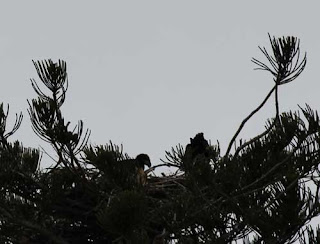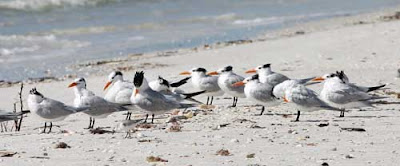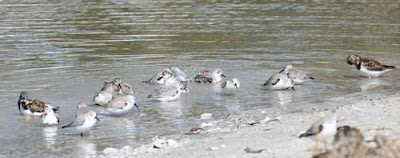Monday, February 7
We went to the Audubon Corkscrew Swamp Sanctuary. Because of
the pandemic, reservation were required. Jane got us tickets for 11:00. The Sanctuary
closed at 3:00; the last tickets available each day were at 1:00. We had plenty
of time to do the 2 ¼-mile boardwalk loop.
Two years ago, Corkscrew was jammed with people, and the
swamp was filled with water. There were fewer people this year, of course. The
decreased revenue must be wreaking havoc on their budget. I inferred that the
area was in the middle of a drought. The water everywhere was low. The “lettuce”
in the Lettuce Lakes, which had previously covered the entire surface to such
an extent that a gallinule could walk right over the water on it, was
restricted to one small area.
Thus, it was not a great day for birding at Corkscrew. Nevertheless, we saw blooming bromeliads,
 |
| A bromeliad in bloom |
Lush fern growth beneath the trees,
 |
| Ferns |
And stately cedars surrounding a pond with alligator flag emerging from it..
 |
| Cedars around a pond. The bundle of bright green in the center is alligator flag. |
There was a rain shelter and platform at a former camping area first for bird hunters and then for bird protectors. The Great Egret, a sign informed us, almost went extinct in the Victorian era because its plumes were in such demand for women’s hats. Not just the plumes either—some hats had the entire bird. Good heavens! That would make a statement, although I’m not sure what that statement would be. “I like to walk around with dead birds on my head”? Anyway, there was a long, long grabber hanging by the side of the shelter. A visitor from another group made a comment about snakes, and I could well imagine that snakes would like to sun on the boardwalk on a cool morning. Later on, though, Jan suggested that the grabber might be to help people retrieve hats or binoculars that had been dropped over the railing. I liked thinking about that rather than removing giant snakes
 |
| Long grabber by the rain shelter--snake removal or hat retrieval? |
There certainly were giant snakes in the sanctuary. Jane spotted this banded water snake lounging on a log with a huge bulge in its belly. I expected it would be there for a good long while. It had to have been a good 4 feet long. Thank God it was far off the trail.
 |
| Banded water snake with lump in its belly |
Here is a picture of a strangler fig hugging another tree.
 |
| A fig hug |
We saw a pileated woodpecker. I got a great picture of the tree branches in front of it, but you can still see its body and red topknot.
 |
| Pileated woodpecker |
On our last visit, we saw an alligator on a log in the Lettuce Lakes. When I looked carefully at my pictures later, I saw that there were baby alligators around her as well. This year, there was an alligator on that same log, but no babies.
 |
| Alligator on a log. Look at the size of that foot! |
We were looking at a Great Egret in the lettuce-less Lettuce Lakes…
 |
| Great Egret |
When a huge alligator head emerged from the water.
 |
| Giant alligator head |
That was followed by a huge alligator back,
 |
| Giant alligator back |
And a long, long body. A man behind me estimated it at ten to fifteen feet long. It cruised by, ignoring us completely (whew!) and went off into the duckweed.
 |
| The whole alligator |
An anhinga plopped into the water and swam right in front of us, spreading its tail like a fan.
 |
| Anhinga underwater |
Nearby, another anhinga dried its wings. I could see that it had webbed feet, which looked strange wrapped around a branch.
 |
| Anhinga with webbed feet wrapped around a branch |
I mentioned the ubiquitous ibis in my last post. We saw them so often on the ground that it seemed odd to see them perched in the trees, sometimes in groups.
 |
| One ibis in a tree |
 |
| Three ibis (ibi?) in a tree |
I noticed these lovely magenta berries long the path. No idea what they are.
 |
| Lovely magenta berries |
We saw one Great Blue Heron.
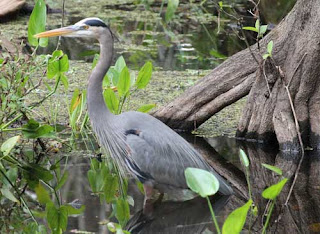 |
| Great Blue Heron |
Toward the end of our walk, two osprey started raising an awful ruckus. They landed on a limb just about our heads and mated, right there. There’s not much to bird mating. Blink, and you’ll miss it. They sat together on the branch for awhile afterwards, grooming as if trying to act casual. I imagined them saying, “Was it good for you too?”
 |
| Two osprey in the afterglow |
Just as we were leaving the boardwalk, a red-shouldered hawk flew by
 |
| Red-shouldered hawk in flight |
And landed in a pine tree.
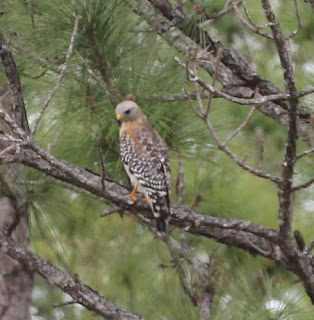 |
| Red-shouldered hawk in a pine |
It was just after 1:00 when we got back. I went to the
restroom while Jane and Jan went to the gift shop. When I returned, I found the
door locked. I tried calling Jane to let me in, but the call didn’t go through.
So I waited outside. A group of people came up to the door and were quite put
out that they could not get in. “If they’re open until three, they should be
open until three,” one grumbled. It was clear that they didn’t have advanced
reservation anyway. Some people.
We had a very late lunch by the water on our way home, and
that was pretty much everything that was worth mentioning about the day.























